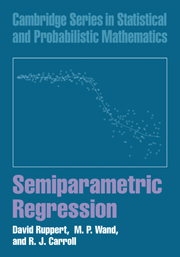Book contents
- Frontmatter
- Contents
- Preface
- Guide to Notation
- 1 Introduction
- 2 Parametric Regression
- 3 Scatterplot Smoothing
- 4 Mixed Models
- 5 Automatic Scatterplot Smoothing
- 6 Inference
- 7 Simple Semiparametric Models
- 8 Additive Models
- 9 Semiparametric Mixed Models
- 10 Generalized Parametric Regression
- 11 Generalized Additive Models
- 12 Interaction Models
- 13 Bivariate Smoothing
- 14 Variance Function Estimation
- 15 Measurement Error
- 16 Bayesian Semiparametric Regression
- 17 Spatially Adaptive Smoothing
- 18 Analyses
- 19 Epilogue
- A Technical Complements
- B Computational Issues
- Bibliography
- Author Index
- Notation Index
- Example Index
- Subject Index
Preface
Published online by Cambridge University Press: 06 July 2010
- Frontmatter
- Contents
- Preface
- Guide to Notation
- 1 Introduction
- 2 Parametric Regression
- 3 Scatterplot Smoothing
- 4 Mixed Models
- 5 Automatic Scatterplot Smoothing
- 6 Inference
- 7 Simple Semiparametric Models
- 8 Additive Models
- 9 Semiparametric Mixed Models
- 10 Generalized Parametric Regression
- 11 Generalized Additive Models
- 12 Interaction Models
- 13 Bivariate Smoothing
- 14 Variance Function Estimation
- 15 Measurement Error
- 16 Bayesian Semiparametric Regression
- 17 Spatially Adaptive Smoothing
- 18 Analyses
- 19 Epilogue
- A Technical Complements
- B Computational Issues
- Bibliography
- Author Index
- Notation Index
- Example Index
- Subject Index
Summary
The primary aim of this book is to guide researchers needing to flexibly incorporate nonlinear relationships into their regression analyses. Flexible nonlinear regression is traditionally known as nonparametric regression; it differs from parametric regression in that the shape of the functional relationships are not predetermined but can adjust to capture unusual or unexpected features of the data.
Almost all existing regression texts treat either parametric or nonparametric regression exclusively. The level of exposition between books of either type differs quite alarmingly. In this book we argue that nonparametric regression can be viewed as a relatively simple extension of parametric regression and treat the two together. We refer to this combination as semiparametric regression. Our approach to semiparametric regression is based on penalized regression splines and mixed models. Indeed, every model in this book is a special case of the linear mixed model or its generalized counterpart. This makes the methodology modular and is in keeping with our general philosophy of minimalist statistics (see Section 19.2), where the amount of methodology, terminology, and so on is kept to a minimum. This is the first smoothing book that makes use of the mixed model representation of smoothers.
Unlike many other texts on nonparametric regression, this book is very much problem-driven. Examples from our collaborative research (and elsewhere) have driven the selection of material and emphases and are used throughout the book.
The book is suitable for several audiences. One audience consists of students or working scientists with only a moderate background in regression, though familiarity with matrix and linear algebra is assumed. Marginal notes and the appendices are intended for beginners, especially those from interface disciplines.
- Type
- Chapter
- Information
- Semiparametric Regression , pp. xiii - xivPublisher: Cambridge University PressPrint publication year: 2003

